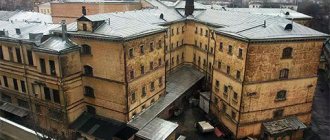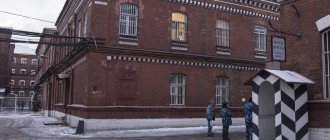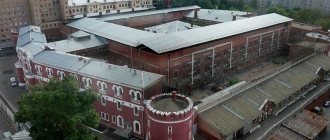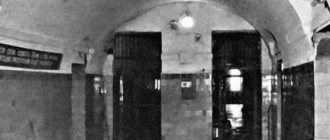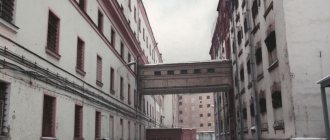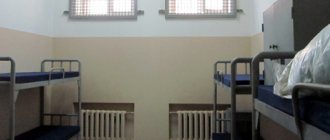Many people know the group “Butyrka”. “Butyrskaya Prison” is one of her most famous songs. Many people know it, especially the older generation. Although some young people do not mind listening to the songs of the group “Butyrka” (Butyrka Prison, “Vestochka” and others).
For many, these compositions also remind us of pre-trial detention center No. 2. It is considered the largest in the city of Moscow. Where is Butyrskaya prison located? It is located in the Tverskoy district on Novoslobodskaya street.
The prison building, which is located near the city square, formed on the site of the Kamer-Kollezhsky Val observation post, is considered an architectural monument of the capital.
Butyrka prison
Butyrsky pre-trial detention center
(pre-trial detention center No. 2 of Moscow), also known as
Butyrskaya prison
,
“Butyrki”
, or
“Butyrka”
is a pre-trial detention center in Moscow, the largest prison in the Russian capital, one of the oldest and most famous prisons in Russia. It is located in the Tverskaya Central Administrative District on Novoslobodskaya Street (house 45), near the Butyrskaya outpost, from which the institution took its name.
The prison building is on the list of state-protected historical and architectural monuments.
Detention center today
The construction of the complex was determined to be outside the city limits. But since Moscow was upset, the prison ended up almost in the center of the capital.
Now the Butyrsky prison complex is officially considered a pre-trial detention center for the city of Moscow.
The prison territory consists of 18 three-story buildings, which are designed for 435 cells (101 of them, measuring 72 m², are common). In addition, Butyrka has 32 specially isolated cells (punishment cells) for isolating prisoners who violate the established rules.
In pre-trial detention center No. 2 (Butyrskaya prison) there can be up to 3,500 people. There are currently about 2,700 people under investigation there. Since 1992, church services have been held again in the Orthodox Petrovsky Church.
Story
During the reign of Catherine II, the barracks of the Butyrsky Hussar Regiment were built in the Butyrsky farm. There was a wooden fort nearby.
Before his execution in January 1775, Emelyan Pugachev was kept in chains in the basement of a tower preserved on the territory of the modern prison, which now bears his name.
In 1784, Catherine II, in a letter to Moscow Governor-General Zakhar Chernyshev, agreed to the construction of a stone provincial prison castle at the Butyrskaya outpost instead of the existing wooden prison. Attached to the letter was a general plan of the future prison.
The prison building was designed by the outstanding Moscow architect Matvey Kazakov. Butyrka Castle had 4 towers: “Pugachevskaya” (until 1775 - South), “Police”, “North”, “Chasovaya”. In the center of the Butyrsky provincial prison castle, the Intercession Church was built in 1782, also according to Kazakov’s design.
Since 1868, the institution was the central transit prison, through which about 30 thousand people passed annually. The current prison building was built in 1879. The prison housed carpentry, bookbinding, shoemaking, tailoring workshops, as well as workshops for making Viennese chairs and wood burning. The Sergiev-Elisavetinsky shelter was also organized for wives and children who voluntarily followed the exiles to Siberia.
L.N. Tolstoy, while working on the novel “Resurrection,” in January 1899 visited the warden of Butyrka prison I.M. Vinogradov and asked him about prison life. In April 1899, Tolstoy came to Butyrka prison to walk with convicts sent to Siberia to the Nikolaevsky station, and then depicted this path in the novel.
During the December uprising of 1905, vigilantes (mainly workers of the Miussky tram park, as well as Savelovsky and Brest railway workers) tried to seize the prison, but were repulsed by the escort team; the fighting continued until December 14, when Miussky Park was liberated by a detachment of dragoons. In 1907, an investigative department was created in the prison. In 1908, a convict department (“Temporary Central”) was created in the Butyrka prison. In 1905-10, Ivan Kalyaev, Nikolai Shmidt, sailors from the mutinous cruiser Ochakov, and Vladimir Mayakovsky were kept in prison.
In 1908, illusionist Harry Houdini performed in Butyrka. In 28 minutes, to the jubilation of the prisoners, he managed to free himself from a special transport “box” in which prisoners were transported from Moscow to Siberia. The maestro was shackled and chained, locked in a container with the lid pushed against the wall, but he overcame all obstacles on the path to freedom.
In 1911-1917 N.I. Makhno was kept in Butyrki. Like all political prisoners, he was released during the February Revolution. On March 1, 1917, Felix Dzerzhinsky, who had been sentenced the year before to 6 years of hard labor, was released from Butyrka prison.
After the October Revolution of 1917, Butyrka Prison was used as a remand and transit prison. In 1921, former army commander F.K. Mironov was held in Butyrki and killed by a sentry. The prison church was closed in 1922.
During the Great Terror in 1937-1938, up to 170 people were imprisoned in each cell. In total, about 20 thousand people were kept in prison at the same time. [1] Thousands of prisoners were shot at the end of the investigation.
During the Great Patriotic War, part of the prison was converted into workshops, where prisoners worked for the needs of the army.
In Butyrka prison, scenes were filmed in the premises of the RSHA building during the filming of the series “Seventeen Moments of Spring.” [2]
The most famous escape
The most high-profile escape from Butyrka prison is considered to be the escape from a specially guarded cell of three prisoners sentenced to life imprisonment for committing several murders in Russia.
Over the course of several days, they used aluminum spoons to dig a hole in the cement floor, through which they entered the water supply collector, and climbed out through a pipe to the street located outside the prison.
Two criminals were caught in the Moscow region three weeks after the escape. The third (the organizer of the escape) was caught two years later.
The prison is currently
Currently, the prison is used as the largest pre-trial detention center in Moscow. This is a complex of about 20 three-story buildings. Also in the 1980s, a multi-storey residential building was given over to the needs of the prison. The prison has 434 cells, of which 101 are general cells measuring approximately 6 x 12 meters. The coat hooks on the walls indicate that initially these cells were supposed to house 20-25 prisoners. Another 301 cells have a smaller area: initially, each of them was supposed to accommodate no more than four prisoners. 32 punishment cells are intended for disciplinary punishments.
In total, the Butyrskaya prison should have no more than 3,500 prisoners; currently it houses less than 2,700 people. Before reconstruction, large cells with an area of 75 square meters could accommodate up to 60 people who slept here in 3-4 shifts (in 1996 there were more than 120 prisoners in such cells).
Since 1992, the Orthodox Church of the Intercession has been operating in the prison again.
In May 1994, several “authorities”, former prisoners, led by Sibiryak (Sergei Lipchansky) decided to visit their comrades in Butyrka prison, having agreed with the staff of the institution. But law enforcement agencies became aware of this and 34 people were detained - employees of the detention center and “guests”. Two prison employees were sentenced to a year in prison, many were fired at their own request or sent to retirement.
Since 1996, the Butyrka prison, with the exception of the hospital's psychiatric ward, no longer houses women.
One of the most famous prisoners of recent times is Vladimir Gusinsky, who spent three days in prison in June 2000.
On January 28, 2008, Deputy Director of the Federal Penitentiary Service of the Russian Federation Vladimir Semenyuk told reporters that “there were people who wanted to buy this building from us, but we said: build us a detention center, and take this one.” However, according to him, when investors began to calculate in more detail the cost of building a new detention center, they abandoned the deal. [3]
There has been a museum attached to the prison since 1971. A visit is possible only as part of an excursion upon application from a legal entity.
How to get to the architectural monument?
The address of Butyrka prison is known to many residents of the capital. But for city guests such information may be useful. Therefore, it is worth recalling the address of Butyrskaya prison: Moscow, Novoslobodskaya street, 45.
The detention center is located 4 km from the center of the capital. You can get to the architectural monument using the Moscow Metro. You need to go to the Mendeleevskaya station (380 meters from the prison) or Novoslobodskaya station (800 meters).
Description of the prison
Pre-trial detention center No. 2 of the Federal Penitentiary Service, or simply Butyrka, is a kind of record holder among penitentiary institutions in Russia. This is not only the oldest and largest, but also, perhaps, the most famous place of detention in our country.
The address of the Butyrskaya prison, which received its name from the outpost of the same name, has not changed since its founding in 1771 - Moscow, st. Novoslobodskaya, 45. The official name of the institution is FKU SIZO-2 of the Federal Penitentiary Service of the Russian Federation of Moscow (Pretrial Detention Center No. 2).
You can get to Butyrka on foot from the Savelovskaya, Novoslobodskaya and Mendeleevskaya metro stations.
As of 2021, just over 2.5 thousand people are kept on the territory of the institution, which is also an important historical and architectural monument. However, the maximum number of prisoners simultaneously residing within the walls of this pre-trial detention center significantly exceeded all permissible standards.
This contributed to the smooth exchange of information and the formation of close ties between representatives of various criminal groups.
The relationships that developed over many years of imprisonment most often continued in the wild, which increased the growth of crime and further strengthened the authority of criminals.
Butyrka’s fame is connected not only with the personalities of those who were “lucky” to serve their sentences in this prison, but also with the frequent mentions of its name in poetry, music, literature and cinema.
Another important feature of this institution is the museum, opened in 1971 and storing the brightest pages of its history. It is located on the 3rd floor of the Pugachev Tower - where the cells for political prisoners used to be.
But even if you know where the Butyrka prison is located, it’s unlikely that you’ll be able to visit the museum right away. The fact is that tours of the prison are by appointment only.
Museum in the Pugachev Tower
Since 1971, a museum began to operate, which contains authentic documents related to the history of the Butyrsky detention center, products made by prisoners in different years of the prison castle’s existence, and many other exhibits.
The museum was created in the year of the 200th anniversary of the start of construction and is located on the third floor of the Pugachev Tower. The exhibitions are located in former cells where political prisoners of Tsarist Russia were kept in past times. You can visit the museum only as part of a tour group. Children under 14 years of age are prohibited from entering the territory.
From the history of Butyrka
Pre-trial detention center No. 2, founded by order of Catherine II, has a long and eventful history.
The chief architect of the Provincial Prison Castle, as Butyrka was called in ancient times, was Vladimir Kazakov. The author's original idea was to build a hexagonal elongated ensemble, at the corners of which 4 round towers should rise, connected by high brick walls.
Oddly enough, the author of the castle never deviated from his main idea, so this project soon came to life. Moreover, the prison towers were even given names - Pugachevskaya, Northern, Police and Chasovaya.
At first there was a small church on the territory of the pre-trial detention center. Now in its place stands the Orthodox Church of the Intercession, which prisoners can visit without hindrance.
Today, Butyrka includes 20 3-story buildings, which house three dozen punishment cells for serving disciplinary punishments and more than 400 cells. Of these, 101 rooms belong to common cells, the dimensions of which do not exceed 6 x 12 m.
Hooks hanging on the walls indicate that it was originally planned to house 20-25 prisoners in this area.
There are also barracks in the prison, the area of which is 75 square meters. m. There could be about 60 people in them at the same time, sleeping in 3-4 shifts.
Since 1996, no women have been placed in Butyrka Prison . The only exception is the psychiatric department of the hospital.
Escape story
Until 1905, there were no escapes from Butyrka prison. From 1905 and over the next eight years, two successful escapes were made.
In the post-Soviet period, eight escapes from the Butyrsky detention center were recorded. In 1992, two people under investigation in a criminal case successfully escaped.
Four years later, two prisoners, walking along the prison yard, peeled back the bars and descended from the roof onto the street using a pre-prepared rope.
In 2000, the organizer of a Georgian criminal group fled from the investigator’s office and was caught a few days later. In 2001, after a meeting with his mother, Ivan Vinogradov, a suspect in the case of an attack on a police officer, went to the checkpoint and, presenting to the duty officer a fake investigator’s ID, which had previously been made in prison workshops, calmly went out into the street, but was caught a few days later .
In 2010, a resident of Belarus, Vitaly Ostrovsky, who was suspected of a series of thefts in his country and was hiding in Russia, made a phenomenal escape from custody. The escape took place while being escorted along a prison corridor. Ostrovsky, pushing the accompanying guard to the side, jumped over the five-meter bars and left the prison territory.
He was successful in his escape, as he was the champion of Belarus in overcoming the barriers of urban space (parkour). Ostrovsky was caught in Finland two years later.
Conditions of detention
Conditions of detention in pre-trial detention center No. 2 are quite strict. Humiliation from guards and cellmates has long become commonplace.
The cells are overloaded with prisoners, so, like many years ago, they are forced to sleep in turns (3-4 hours a day). The premises are practically not ventilated - there is a smoke screen in them, which makes it difficult to breathe.
Exit to the yard is carried out irregularly, which also contributes to the development of serious diseases.
Sanitary standards are far from ideal. The barracks are dirty and stuffy, the air temperature almost never meets the standards. There are also so-called small cells or special cells in Butyrka, which have more favorable conditions of stay .
True, you can get into them only through connections and only for a lot of money. By the way, increasing the authority of a prisoner is promoted not only by the financial viability of his relatives, but also by the frequency of parcels - the more of them, the better.
Communication between cameras occurs using special “roads”, thin ropes stretched between the windows.
Features of visits
The Butyrka prison in Moscow has the following admission conditions. Let's consider only the main ones:
If there is an attempt to transfer to the accused or suspect prohibited substances, items and food products, as well as information that impedes the establishment of the truth in a criminal case or contributes to the commission of a new crime, the meetings are terminated early.
Meetings with a lawyer in pre-trial detention center No. 2 in Moscow are held confidentially (that is, without the presence of a guard) . Their number and duration are not limited by any limits.
The only exceptions are those cases provided for by the Code of Criminal Procedure of the Russian Federation. To receive a visit, a human rights defender must present a warrant and his own identification.
Receiving parcels in Butyrka
SIZO-2 Butyrka puts forward special requirements not only for visits, but also for the acceptance of parcels or transfers . The latter come in several types:
Grocery monthly
The permissible weight of such a transmission is 30 kg.
The only exception to the rule is those addressed to seriously ill prisoners. However, to do this they are required to obtain a medical report from the prison doctor.
You must bring a clean bag of sugar along with the food, otherwise the receivers will simply have nowhere to put it.
Grocery through the Trustee store
Not limited by any time or weight limits (except for some products).
Clothing
Can be transferred once every 6 months. They are staffed according to the time of year, so in winter it is very cold in Butyrka, and in summer you can’t breathe.
In addition to clothing and shoes, antennas, televisions, low-power heaters, fans and even refrigerators can be transmitted.
However, first you should consult with the staff of the pre-trial detention center - excessive consumption of electricity can lead to some difficulties.
To register food and clothing parcels, you should go to one of the windows located on the left at the entrance to the prison (divided by letters of the alphabet: 1 - from A to L, 2 - from M to Z), and tell the employee the name of the prisoner you need.
He checks when such actions were last performed, and, if everything is fine, issues a special form. To save time and stress, try to fill it out correctly the first time.
Medicinal
The transfer of medications is carried out through a special kiosk located at the entrance and operating on the principle of a pharmacy.
To register a medicine parcel, you need to write down all the necessary drugs on the form (the list of those available hangs on the kiosk itself) and make payment - everything is quite easy.
The only important condition is that the prison administration receives only medications that are prescribed to the prisoner by the attending physician (Federal Law No. 161-FZ of December 8, 2003).
As a rule, transfers are issued the next day (except weekends and holidays). At the same time, they are carefully checked for the presence of prohibited items, substances or food products.
An attempt to hide from inspection or transfer to prison objects and substances that pose a danger to the life and health of people entails criminal and administrative liability.
If you wish, you can use it, which allows you to sign up for a date or make a transfer online.
As for the parcel delivery method, it can be of different types:
Correspondence
Accused and suspects staying in Butyrka can conduct unlimited correspondence with relatives, acquaintances or other persons.
In this case, the prisoner pays for postal services himself. Receiving and sending letters and telegrams is carried out through the prison administration and is subject to strict censorship.
Correspondence that is not sent to the addressee, but handed over to the relevant legal authority, includes correspondence:
The delivery of letters addressed to the prisoner, as well as the sending of his messages to the addressees, are carried out by the administration of Butyrka within 3 days from the date of their receipt or delivery (except weekends and holidays).
In case of translation into the state language of the Russian Federation, this period may be extended. Information about a serious illness or death of a close relative is reported immediately.
If the prisoner has been transferred to another prison, all correspondence received during the period of his absence is sent to the place of departure.
Now you know what Butyrka is, and you can imagine what conditions this penitentiary institution offers.
Source
Moscow legend: Butyrka prison
Discussions about what can be done with Moscow’s oldest prison, Butyrka, have not subsided over the past few years. It objectively needs repairs, and therefore many experts propose to close it and build a modern insulator instead. There are also proposals to give it away as an art cluster. What is the history of Butyrka and what might emerge in its place in the future?
Not long ago, Deputy Head of the Federal Penitentiary Service of the Russian Federation Valery Maksimenko made a statement that interested everyone: law enforcement officers, human rights activists, prisoners, their lawyers, historians, and just citizens. The oldest prison in Moscow, Butyrka, is being closed, and a modern pre-trial detention center will be built in its place in New Moscow. However, soon after this, the head of the Butyrsky pre-trial detention center, Sergei Telyatnikov, in a conversation with Russian journalists, Fr. Thus, it was officially confirmed that the old prison would live to see its 260th anniversary without any major changes.
The history of the detention center began in 1771, when Catherine II ordered the construction of a new large prison in Moscow. Its project was entrusted to the outstanding architect Matvey Kazakov, the creator of the Moscow State University building on Mokhovaya and the Senate Palace of the Moscow Kremlin. The master made Butyrka according to the canons of a classic castle - with four towers, while its configuration has not undergone major changes since then. The official opening date of the prison is considered to be 1775. At the same time, the first known prisoner appeared there: it was in Butyrka that the leader of the rebel Cossacks, Emelyan Pugachev, awaited execution. The tower where he was kept still bears the name of the Cossack chieftain. And Kazakov then designed a temple inside the prison. In the 20th century it will be dismantled by the Bolsheviks.
Pugachev, imprisoned in a cage. 1774
Pugachevskaya Tower
A hundred years after its creation, Butyrka became not only a place for serving sentences, but also a transit prison. There, those sentenced to long sentences were waiting to be sent to hard labor. At the same time, one of the first criminal communities was formed on the territory of the detention center. Its participants set up the production of counterfeit money right on the territory of the prison, which they sold outside. Criminals legally purchased small denomination notes from banks, etched out the numbers and wrote new, larger amounts on top of them. Equipment for counterfeiting money was kept secretly in one of the cells. Communication with the outside world for the attackers was provided by the lawyer of one of the inmates, Lazarev.
According to the memoirs of the famous lawyer Fyodor Plevako, the criminal group was international: it included Russians, Germans, Jews, Armenians and Poles. As stated in the indictment of 1877, one of its members named Matusevich, who was a secret police agent, helped uncover the activities of the criminal community.
In the second half of the 19th century, Leo Tolstoy visited Butyrka several times. “He visited this detention center several times when he was working on his novel “Resurrection.” In particular, he communicated with the convicted Narodnaya Volya member Yegor Lazarev, who became the prototype of the revolutionary Nabatov. Lev Nikolaevich also talked a lot with one of the prison guards, Mikhail Vinogradov. The latter left written memories of his meetings with the writer on the prison grounds, from which we can conclude that Tolstoy took a detailed interest in the life of the prisoners and even walked with them from the Butyrka building to the Nikolaevsky station,” says Valentina Bastrykina, librarian of the Tolstoy Museum in Moscow.
With the beginning of the 20th century, Butyrka prison and its employees found themselves at the epicenter of revolutionary events. During the December armed uprising of 1905, workers of the Miussky tram park (where the largest food court in Moscow now operates) decided to seize the prison and release political prisoners. They launched several attacks, but each time the guards repelled the assault.
“Today there was shooting near Miussky Park, on Lesnaya Street and on Bronnaya, where barricades were set up... The revolutionaries burst into the apartment of the chief of the detective police, Voylochnikov, dragged him into the yard and, despite the pleas of the children, shot him. In Miussky Park, a technical school was badly damaged by gunfire. Up to a hundred revolutionaries were arrested,” this is how the events are described in the issue of the newspaper “Novoe Vremya” dated December 15, 1905. By an evil irony of fate, one of the organizers of the uprising, Nikolai Shmit, was also imprisoned in Butyrka prison and was killed there under unclear circumstances.
In 1910–1917, Butyrka was replenished with new political prisoners. These are the anarchist Nestor Makhno, the murderer of Prince Sergei Alexandrovich Romanov Ivan Kalyaev and the poet Vladimir Mayakovsky. “The most important time for me. After three years of theory and practice, I threw myself into fiction. I've read all the latest ones. Symbolists - Bely, Balmont. The formal novelty was dismantled. But it was alien... I tried to write just as well, but about something else. It turned out that the same cannot be said about other things. It came out stilted and tearful. I filled a whole notebook with this. Thanks to the guards - they took me away when I left. Otherwise I would have printed it again!” — this is how Vladimir Vladimirovich described the Butyrka period in his memoirs.
Vladimir Mayakovsky's registration card
Solitary cell No. 103, in which prisoner Vladimir Mayakovsky was sitting
At the same time, Mayakovsky was not the only writer who was engaged in self-education within the walls of the detention center. The writer Varlam Shalamov, who was repressed during the Soviet years and was held in Butyrka already in the 1930s, also read a lot there. At that time, the prison came under the jurisdiction of the OGPU, and then the NKVD. Around the same time, a women’s block was organized in the prison. It was placed separately from the men's, so that the prisoners of the two sections did not intersect.
“At the disposal of the prisoners was the amazing Butyrka library, the only library in Moscow, and perhaps in the country, that had not experienced all sorts of seizures, destruction and confiscations, which in Stalin’s time forever destroyed the book collections of hundreds of thousands of libraries... There you could also get Iles’s “The Internationale” , and “Notes of a Freemason”, and Bakunin, and “The Tale of the Unextinguished Moon” by Pilnyak, and “The White Guard” by Bulgakov. There were a lot of scientific books there, a lot of self-teaching books, and our chamber “book commission” chose a fair number of books for classes... We studied languages - whoever wanted to, just read,” Shalamov recalls his stay in Butyrka prison.
Butyrka's first prisoner
According to historical documents, the first prisoner of the Butyrka prison in Moscow was the leader of the Peasant Uprising, Don Cossack Emelyan Pugachev. At the end of 1774 the revolt was suppressed. Then Pugachev was arrested. Afterwards he was taken to Moscow and placed in one of the towers of the Butyrka prison.
Before the execution of the death sentence, the prisoner was kept in a cage under heavy security. Now this tower is called “Pugachevskaya”, and the cage is located in the Moscow Historical Museum.

